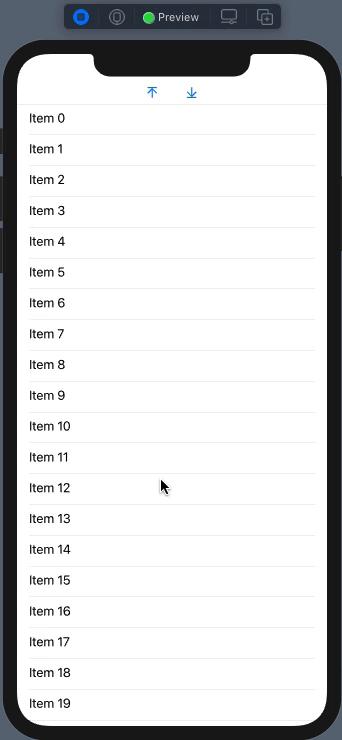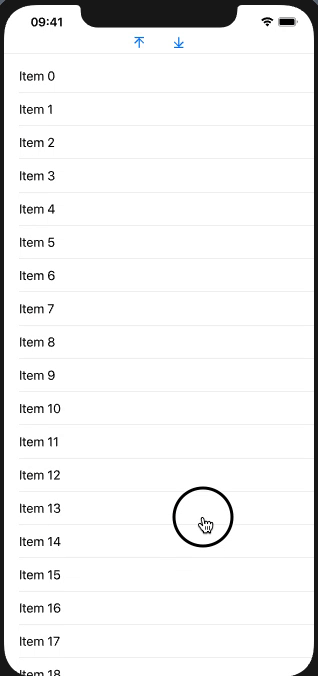How to make a SwiftUI List scroll automatically?
Update: In iOS 14 there is now a native way to do this.
I am doing it as such
ScrollViewReader { scrollView in
ScrollView(.vertical) {
LazyVStack {
ForEach(notes, id: \.self) { note in
MessageView(note: note)
}
}
.onAppear {
scrollView.scrollTo(notes[notes.endIndex - 1])
}
}
}
For iOS 13 and below you can try:
I found that flipping the views seemed to work quite nicely for me. This starts the ScrollView at the bottom and when adding new data to it automatically scrolls the view down.
- Rotate the outermost view 180
.rotationEffect(.radians(.pi)) - Flip it across the vertical plane
.scaleEffect(x: -1, y: 1, anchor: .center)
You will have to do this to your inner views as well, as now they will all be rotated and flipped. To flip them back do the same thing above.
If you need this many places it might be worth having a custom view for this.
You can try something like the following:
List(chatController.messages, id: \.self) { message in
MessageView(message.text, message.isMe)
.rotationEffect(.radians(.pi))
.scaleEffect(x: -1, y: 1, anchor: .center)
}
.rotationEffect(.radians(.pi))
.scaleEffect(x: -1, y: 1, anchor: .center)
Here's a View extension to flip it
extension View {
public func flip() -> some View {
return self
.rotationEffect(.radians(.pi))
.scaleEffect(x: -1, y: 1, anchor: .center)
}
}
How to get a horizontal ScrollView in SwiftUI to scroll automatically to end when the enclosed Text is updated
I assume you wanted this:
ScrollViewReader { scrollView in
VStack {
ScrollView(.horizontal) {
Text(model.combinedString)
.id("combinedText")
}
.onChange(of: model.combinedString) { // << here !!
withAnimation {
scrollView.scrollTo("combinedText", anchor: .trailing)
}
}
}
}
How to scroll List programmatically in SwiftUI?
SWIFTUI 2.0
Here is possible alternate solution in Xcode 12 / iOS 14 (SwiftUI 2.0) that can be used in same scenario when controls for scrolling is outside of scrolling area (because SwiftUI2 ScrollViewReader can be used only inside ScrollView)
Note: Row content design is out of consideration scope
Tested with Xcode 12b / iOS 14

class ScrollToModel: ObservableObject {
enum Action {
case end
case top
}
@Published var direction: Action? = nil
}
struct ContentView: View {
@StateObject var vm = ScrollToModel()
let items = (0..<200).map { $0 }
var body: some View {
VStack {
HStack {
Button(action: { vm.direction = .top }) { // < here
Image(systemName: "arrow.up.to.line")
.padding(.horizontal)
}
Button(action: { vm.direction = .end }) { // << here
Image(systemName: "arrow.down.to.line")
.padding(.horizontal)
}
}
Divider()
ScrollViewReader { sp in
ScrollView {
LazyVStack {
ForEach(items, id: \.self) { item in
VStack(alignment: .leading) {
Text("Item \(item)").id(item)
Divider()
}.frame(maxWidth: .infinity).padding(.horizontal)
}
}.onReceive(vm.$direction) { action in
guard !items.isEmpty else { return }
withAnimation {
switch action {
case .top:
sp.scrollTo(items.first!, anchor: .top)
case .end:
sp.scrollTo(items.last!, anchor: .bottom)
default:
return
}
}
}
}
}
}
}
}
SWIFTUI 1.0+
Here is simplified variant of approach that works, looks appropriate, and takes a couple of screens code.
Tested with Xcode 11.2+ / iOS 13.2+ (also with Xcode 12b / iOS 14)
Demo of usage:
struct ContentView: View {
private let scrollingProxy = ListScrollingProxy() // proxy helper
var body: some View {
VStack {
HStack {
Button(action: { self.scrollingProxy.scrollTo(.top) }) { // < here
Image(systemName: "arrow.up.to.line")
.padding(.horizontal)
}
Button(action: { self.scrollingProxy.scrollTo(.end) }) { // << here
Image(systemName: "arrow.down.to.line")
.padding(.horizontal)
}
}
Divider()
List {
ForEach(0 ..< 200) { i in
Text("Item \(i)")
.background(
ListScrollingHelper(proxy: self.scrollingProxy) // injection
)
}
}
}
}
}

Solution:
Light view representable being injected into List gives access to UIKit's view hierarchy. As List reuses rows there are no more values then fit rows into screen.
struct ListScrollingHelper: UIViewRepresentable {
let proxy: ListScrollingProxy // reference type
func makeUIView(context: Context) -> UIView {
return UIView() // managed by SwiftUI, no overloads
}
func updateUIView(_ uiView: UIView, context: Context) {
proxy.catchScrollView(for: uiView) // here UIView is in view hierarchy
}
}
Simple proxy that finds enclosing UIScrollView (needed to do once) and then redirects needed "scroll-to" actions to that stored scrollview
class ListScrollingProxy {
enum Action {
case end
case top
case point(point: CGPoint) // << bonus !!
}
private var scrollView: UIScrollView?
func catchScrollView(for view: UIView) {
if nil == scrollView {
scrollView = view.enclosingScrollView()
}
}
func scrollTo(_ action: Action) {
if let scroller = scrollView {
var rect = CGRect(origin: .zero, size: CGSize(width: 1, height: 1))
switch action {
case .end:
rect.origin.y = scroller.contentSize.height +
scroller.contentInset.bottom + scroller.contentInset.top - 1
case .point(let point):
rect.origin.y = point.y
default: {
// default goes to top
}()
}
scroller.scrollRectToVisible(rect, animated: true)
}
}
}
extension UIView {
func enclosingScrollView() -> UIScrollView? {
var next: UIView? = self
repeat {
next = next?.superview
if let scrollview = next as? UIScrollView {
return scrollview
}
} while next != nil
return nil
}
}
backup
Related Topics
How to Deal With @Objc Inference Deprecation With #Selector() in Swift 4
How to Use String.Substringwithrange? (Or, How Do Ranges Work in Swift)
How to Save and Read Array of Array in Nsuserdefaults in Swift
How to Convert Unix Epoch Time to Date and Time in iOS Swift
Accessing Code in Swift 3 Error
Prevent Dismissal of Uialertcontroller
Convert a Two Byte Uint8 Array to a Uint16 in Swift
Saving Cgimageref to a Png File
How to Convert Array of Bytes [Uint8] into Hexa String in Swift
How to Dispatch_Sync, Dispatch_Async, Dispatch_After, etc in Swift 3, Swift 4, and Beyond
Overriding Superclass Property With Different Type in Swift
Getting the Decimal Part of a Double in Swift
Using a Type Variable in a Generic
How to Use Assets Catalog Color Sets
Swiftui View and @Fetchrequest Predicate With Variable That Can Change